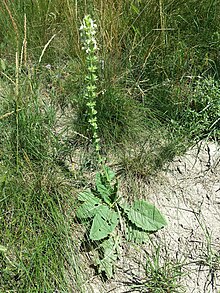Austrian sage
| Austrian sage | ||||||||||||
|---|---|---|---|---|---|---|---|---|---|---|---|---|

Austrian sage flowers ( Salvia austriaca ) |
||||||||||||
| Systematics | ||||||||||||
|
||||||||||||
| Scientific name | ||||||||||||
| Salvia austriaca | ||||||||||||
| Jacq. |
The Austrian Sage ( Salvia austriaca ) is a representative of the family of the mint (Lamiaceae).
description
The Austrian sage is a perennial herbaceous plant that reaches heights of 60 to 80 (rarely 50 to 100) cm. The rungs are densely hairy and have glandular hairs, but are not sticky. The stems are upright, are usually not branched and only carry a pair of leaves .
leaves
The basal leaves lie flat on the ground, have a one to five centimeter long stem and a three to ten (rarely 12) centimeter long blade . The blade is four to eight (rarely nine) centimeters wide, egg-shaped, reticulate-pitted and not regularly serrated. The blade is glabrous on the upper side and only hairy on the nerves on the lower side. The stem leaves are sessile, pinnate and two to five inches long. Sometimes they are also missing. The leaf base is heart-shaped or rounded.
Inflorescence and flowers
The flowers are four to ten (rarely only two) in pseudo whorls . The bracts are herbaceous, pubescent and glandular. The lower bracts are pinnate, further up they are entire, ovate and seven to 10 millimeters long.
The calyx is bell-shaped, eight to ten millimeters long and also dense and hairy with glands. The calyx teeth on the upper lip are short and of equal length. The crown is 15 to 20 (rarely only 12) millimeters long and yellowish-white in color. The corolla tube is hardly longer than the calyx and has no hair ring inside. The upper lip is slightly curved. The crown is covered with dark red glandular hair. The stamens protrude far from the corolla tube. They have very long connecting legs and are spreading. Flowering time is May to September.
The partial fruits are around three millimeters long and have an ellipsoidal shape.
Chromosome number
The number of chromosomes is 2n = 18.
Distribution and locations
The Austrian sage has a Pontic-Pannonian distribution area (steppes north of the Black Sea - Hungarian lowlands ). In Austria it occurs only in the Pannonian region of northern Burgenland , Vienna and Lower Austria and is considered to be endangered here. The distribution area extends from Central Europe to southern European Russia.
It occurs in dry pasture grass and light shrubbery and is limited to the colline altitude .
literature
- Siegmund Seybold (Ed.): Schmeil-Fitschen interactive (CD-Rom), Quelle & Meyer, Wiebelsheim 2001/2002, ISBN 3-494-01327-6
- Manfred A. Fischer , Karl Oswald, Wolfgang Adler: Excursion flora for Austria, Liechtenstein and South Tyrol. 3rd, improved edition. State of Upper Austria, Biology Center of the Upper Austrian State Museums, Linz 2008, ISBN 978-3-85474-187-9 .
Individual evidence
- ^ Salvia austriaca at Tropicos.org. In: IPCN Chromosome Reports . Missouri Botanical Garden, St. Louis
- ↑ Rafaël Govaerts (Ed.): Salvia austriaca. In: World Checklist of Selected Plant Families (WCSP) - The Board of Trustees of the Royal Botanic Gardens, Kew . Retrieved January 14, 2018.
